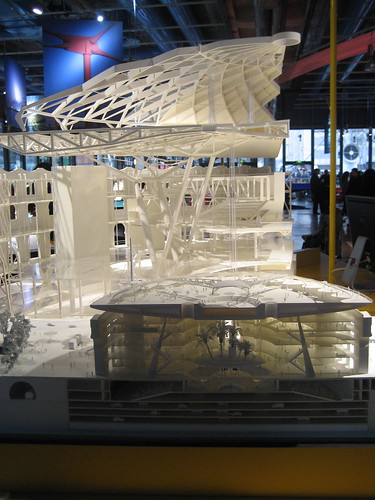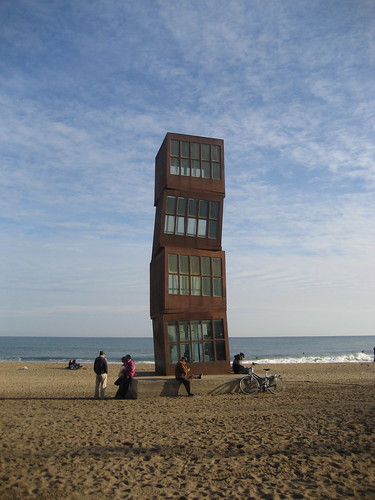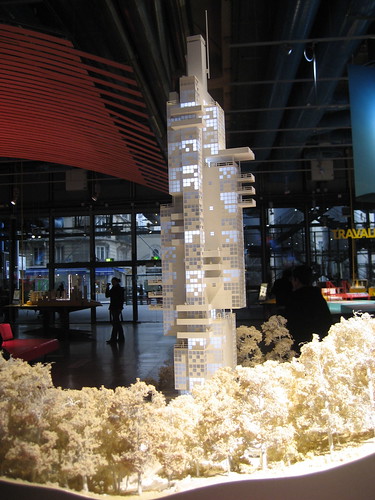Information is something that we often experience with our eyes or ears, but rarely can we touch information and gain a kind response. The dearth of haptic interaction with our information reduces our ability to interact with it on that dimension.
If I were to describe the current reality of haptics in everyday life, I would have to describe it as electronic and non-human. Human hands morph data through keyboards and mice, but cannot actually touch information or understand how it feels.
Gestural Data Management
Progressions have been made in this area. Most notably, the iPhone has allowed one to infer haptic sensation by “pinching” the screen to bring data closer, or pushing to throw data backwards. These gestures bring data into a more three-dimensional existence, but do not actually convey any meaning back to the user via touch.
Vibration as Haptic Simulation
The Wiimote provides vibration, but vibration is an extremely low resolution way of expressing meaning. Vibration could be placed at 1 on the scale of haptic resolution that we experience in everyday life.
What about gestural control of data? Moving objects on a screen from across the room is possible with the Wiimote, but we still cannot touch or feel objects when we touch them. My hypothesis is that our capability to feel data will evolve just as our 8-bit computing systems emerged and evolved into 64 bit systems and beyond. Just like JPEGs compress images, the ability for our bodies to feel virtual data is just beginning. If it grows side-by-side with gesture recognition systems, we’ll grow increasingly accustomed to dealing with data offline and online. It will further blur the boundaries between humans and computers, analog and digital realms.
Juhani Pallasmanaa states the following in the May 2000 edition of Architectural Review:
“The retinal-biased architecture of our time is clearly giving rise to a quest for a haptic architecture.”
Too much stimulus to the eyes makes entire interfaces and realities overwhelm the mind.
“Ashley Montagu sees a wider change taking place in Western consciousness: We in the Western world are beginning to discover our neglected senses. This growing awareness represents something of an overdue insurgency against the painful deprivation of sensory experience we have suffered in our technologized world’. [9] Our culture of control and speed has favoured the architecture of the eye, with its instantaneous imagery and distant impact, whereas haptic architecture promotes slowness and intimacy, appreciated and comprehended gradually as images of the body and the skin.”
All we see of sensual architecture is isolated away from us — set into commercials for Herbal Essences. We can look, but we cannot feel. All we can feel are the slightly soft buttons of the remote control, or the much harder buttons of the keyboard or mouse. It is unyielding — unhumanlike.
“The architecture of the eye detaches and controls, whereas haptic architecture engages and unites. Tactile sensibility replaces distancing visual imagery by enhanced materiality, nearness and intimacy.”
We consider something an “other”, if it is distant from us. When we see Charlie Chaplin fall down, we laugh because we cannot feel the pain. If Charlie is set far enough away from us on the screen, his actions and pain seem far enough away that he becomes an “other” — a clown instead of a relational individual.
“Flatness of surfaces and materials, uniformity of illumination, as well as the elimination of micro-climatic differences, further reinforce the tiresome and soporific uniformity of experience.”
Zoom out and all text looks the same. All websites blur into one. There is no delineation between value.
“All in all, the tendency of technological culture to standardize environmental conditions and make the environment entirely predictable is causing a serious sensory impoverishment. Our buildings have lost their opacity and depth, sensory invitation and discovery, mystery and shadow.”
We have printed depth onto surface, and simulated sensuality long enough. Visual synethasia can only go so far before individuals clamor for the real thing — the actual experience — community, companionship, and touch. Isolation is everywhere.
Source: HAPTICITY AND TIME. (discussion of haptic, sensuous architecture.) The Architectural Review | Date: 5/1/2000 | Author: Pallasmaa, Juhani.








